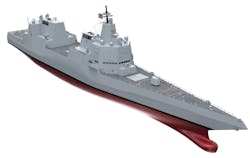Navy looks to next-generation destroyer surface warship with electromagnetic weapons and integrated power
WASHINGTON – U.S. Navy surface warfare experts are taking another step toward building a next-generation guided-missile destroyer eventually to replace the Ticonderoga-class (CG 47) cruisers and early model Arleigh Burke-class (DDG 51) destroyers.
Officials of the Naval Sea Systems Command in Washington announced contracts last month of undisclosed value to two U.S. military shipbuilders for preliminary design of the future Guided Missile Destroyer now known as DDG(X).
Contracts went to General Dynamics Bath Iron Works in Bath, Maine, and to Huntington Ingalls Inc. in Pascagoula, Miss., to carry out preliminary design work for the future DDG(X) surface warship. The value of the contracts was not released because it is competition-sensitive.
Navy leaders say they want to procure the first DDG(X) in 2030, and add the new ship to the fleet as early as 2034. Procurement of Burke-class destroyers would end sometime after 2030. The Navy approved the DDG(X) major features in December 2020.
Navy officials envision the DDG(X) as displacing about 12,700 tons, which would make it larger than the 9,700-ton Flight III Burke-class destroyer and 9,600-ton Ticonderoga-class cruiser, yet smaller than the 15,700-ton Zumwalt-class (DDG 1000) land-attack destroyer.
The new ship also will have a mid-body hull section called the Destroyer Payload Module to provide additional payload capacity. Future capabilities could include laser and electromagnetic weapons; hypersonic missiles; advanced sensors.
At roughly 12,700 tons, the DDG(X) would be close to the size of the 1970s-vintage Virginia-class cruiser, or World War II-era Boston-class cruiser. The ship would be about half the size of the massive Russian Kirov-class battle cruiser.
Navy leaders speculate that the DDG(X), compared to late-model Burke-class destroyers, will have more space, weight-carrying capacity, room for growth; higher-power equipment; reduced infrared, acoustic, and underwater electromagnetic signatures; increased range; and increased weapons capacity.
The new ship also will have elements of the Flight III Burke-class destroyer Aegis combat system, enhance electrical power and cooling capacity, and an integrated power system.
The DDG(X) will have 96 standard Vertical Launch System (VLS) cells, with an ability to incorporate 12 large missile-launch cells in place of 32 of the 96 standard VLS cells, and will include two 21-cell Rolling Airframe Missile (RAM) launchers.
Navy leaders have not specified how many DDG(X) surface warships they want to buy, yet by 2031 could buy as many as three additional ships each year. The ship should cost between $3.5 billion and $4 billion to build.
On these preliminary studies contracts, Bath Iron Works will do the work in Bath and Brunswick, Maine, and in Washington, D.C. Huntington Ingalls will do the work in Pascagoula, Miss.; Avondale, La.; and Newport News, Va. Both companies should be finished by July 2023.
For more information contact Bath Iron Works online at https://gdbiw.com, Huntington Ingalls at https://huntingtoningalls.com, or Naval Sea Systems Command at www.navsea.navy.mil.
About the Author
John Keller
Editor-in-Chief
John Keller is the Editor-in-Chief, Military & Aerospace Electronics Magazine--provides extensive coverage and analysis of enabling electronics and optoelectronic technologies in military, space and commercial aviation applications. John has been a member of the Military & Aerospace Electronics staff since 1989 and chief editor since 1995.
